Musical watches
The history of musical clocks
Musical clocks but if they are mechanical, are extraordinarily complex device. It would seem, to the music we used to from a child: they can be found everywhere - in books, movies, songs ... Pretty simple thing turns out. Agree, sometimes we are the "trinkets" even more underrated ... However, if you set out to buy the mechanical musical clocks, this is a daunting task ... You can get off your feet, spit on the venture, "bury" the idea before something appropriate suddenly appears on the horizon, and may be in any antique shop of a gray-haired old man - a watchmaker. Although today it is easier - and there are quite a few Internet sites, which specialize on a historic and "newborns" musical clocks.
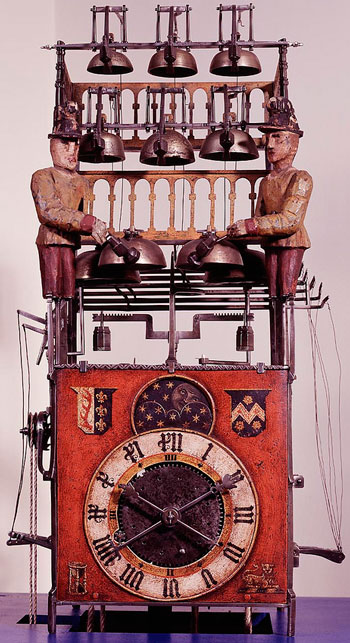
Musical clock-automatons
Today, in the age of high technology, you can find all kinds of watches to suit every taste. At every step it is possible to meet Chinese electronic watches - toys, gaudy fake with primitive chip (click - get "music"), unworthy of attention of collectors. These little things are beyond of interesting of fans, the collectors of precision mechanics. Worthy is to find a mechanism that extends and combines the tradition of jewelry, arts and crafts and, of course, watch crafts, which are rooted in the depths of time, to be exact - in the Middle Ages.
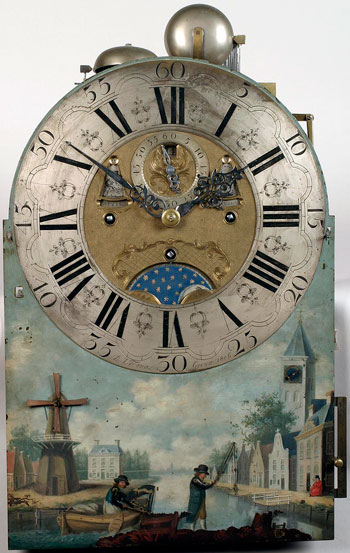
Musical clock-automatons
All sorts of music functions in vintage watch movements, and the "sound indication of the current time," have always been popular among the ordinary people, needless to say what value they represent for connoisseurs and collectors willing to pay for them all: their savings, time, energy, and what could be there - the soul put ... You cannot get by without admiring these masterpieces and not enjoying the sounds of the mechanisms - antique cuckoo clocks (there are variations with the nightingale, rooster), repeaters, carillon, chimes striking clock, automatons . Man always fascinated watch mechanisms. And the desire to look inside was a great, especially when they hear the ornate melodies, played bells, gongs, organs or hammers.
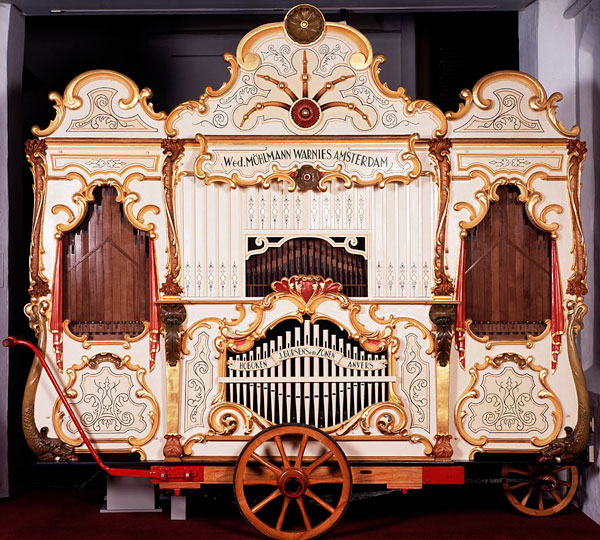
Musical organ
The best-known watch manufacturers with a music device of the eighteenth century was Henry Moser (Switzerland) and Gustav Becker and Lenzkirch (Germany). Among the Russian inventors was Ivan Kulibin, who in the early nineteenth century did the famous clock-theater in the form of a goose egg with animation and three tunes. Now you can see this masterpiece in the Hermitage. France and Switzerland took first place for the production of handheld repeater with gold cases, but by mid-century musical watches and clocks had almost disappeared from the horizon. Only watchmakers of Charles Reuge factory continue to create, in the result appears not only watches with musical mechanism but ornate music boxes and even a hurdy-gurdy. In the twentieth century, musical alarm clocks Junghans and Soviet Nairi are put on stream. And here is a miracle! In the 70-80th years of the twentieth century seems to have forgotten musical pocket watches again begin to find their way, and even in the class of luxury gifts. The main producer of mechanisms was Switzerland, in particular factory Reuge. At the time the stage there are different watches with music, repeater, automatons (animation). Despite the fact that this is not our path, we should mention the "champion" of nineties - electronic watches with tunes - Montana, Soviet Electronics and American watch with Mickey Mouse. Today, miniature musical watches are produced by only two factory - Reuge (pocket watches and music boxes) and Christophe Claret (manufacturing wrist watches to order). Fine-tuning the final watches on the basis of the above mechanisms involved Boegli, Jacquet-Droz, Girard Perregaux, Arnex and Gruen.
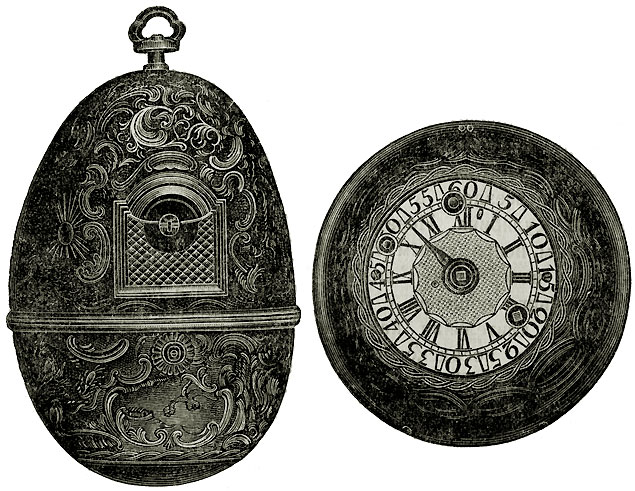
Watch - theater in the form of a goose egg with animation and three tunes by Ivan Kulibin
Antique clock is still going...
There are several types of musical clocks. The most frequent is striking clock. They can be desktop, and pocket, but the most common form – it is a classic wall clock, which was created by the masters in the late 19th - early 20th century. In particular time they fight off the right number of hours, half an hour or even quarters. Usually the sound of the battle (be it a beat or an accord) are involved tiny mechanical hammers banging at a certain time on a bell or gong.
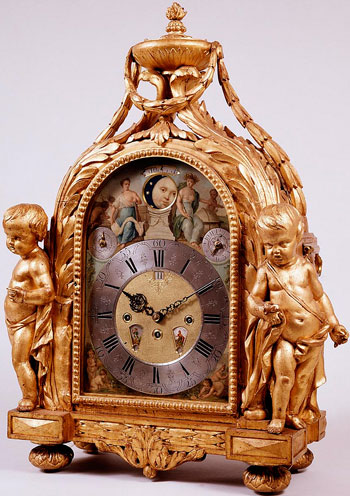
Musical clock-automatons
Many believe that the striking clock, and repeater (which we will discuss later) – is the same. It is not so. Of course, they live well in one package, but it is rather a good neighborhood than interchangeable things. Striking clocks, as opposed to watches with repeater, sound time, even when the owner of the mechanism is not interested. Striking clock can be wall, desktop, pocket, and even floor. In addition, this includes and chimes. The clock on the Spasskaya Tower of the Moscow Kremlin - this is what they are. This type of mechanism has a single melody, at least - three. Musical clocks include cuckoo clocks. If there is no cuckoo, it is usually replaced by a nightingale or a cockerel. Such a clock do not leave anybody indifferent to. Sometimes the clock with music includes alarm clocks - tune plays as long as the spring wind of musical mechanism is finished. It should be noted that all types of musical clock is difficult to find on the market, and if you are lucky enough to do it, then cook break the bank to get them - they are quite expensive, because their production process is very complex, and the master spends a lot of effort to please connoisseurs. Particularly difficult is to buy a watch-theater, but this kind of masterpieces is being looked mostly by avid collectors. For all that simple pocket watches with a built music box can be found in the company's stores Reuge, Gruen, Boegli. They cost about $ 1,500. These toys are so nice, but the lack of correlation time and musical arrangements is a little sad. But if you decide to give someone a such "trinket", in any case, it will be a great gift! As an example is the original music boxes Reuge - iReuge or Arche, which it presented at the Montreux Jazz Festival in 2012. iReuge - it is also a work station for the iPhone 4 and 4S. Boxes play melodies, became classics - "Smoke On The Water" by Deep Purple, "Respect" by Aretha Franklin, and "What's going on" by Marvin Geyya.
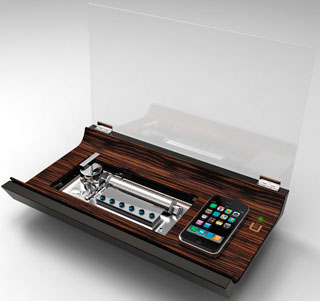
Musical box iReuge |

Musical box Arche |
The next type of musical clocks – is a carillon. In these clocks there are three or more gong (if the pocket watch) or bell (if it is the large clock). And each of them is responsible for a specific note. The result is a beautiful harmony. The first wristwatch-carillon was produced by Audemars Piguet - model "Jules Audemars Grande Sonnerie Repetition Minutes Carillon". There are two types of models - Petite Sonnerie and Grande Sonnerie with power reserve of 60 hours and 20 hours.
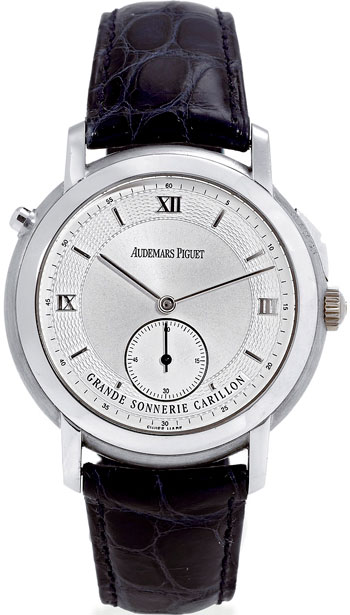
Jules Audemars Grande Sonnerie Repetition Minutes Carillon watch
However, the company Patek Philippe went ahead of giants and created watches with musical mechanism "Star Caliber 2000" with five gongs, which allow recapture Westminster chime. Watch - carillon – it is a huge rarity in today's market, so its price is very high.

“Star Caliber 2000”
There is a subspecies of the musical clock, very rare – it is a clock with organ. Instead of stroke can be heard long melodies. The sound in these mechanisms is based on the interaction of valves and pipes. These clocks are located in the world's museums.
a.jpg)
Musical clock with organ
Watch that sounds
Repeaters are called "speaking watches", "watches that sound." The first truly portable clock was shown at the beginning of the sixteenth century. Their appearance was caused by a problem, which in those days was intractable. Now it is easy to say, any time you can turn on and turn off the lights, but before dusk created great inconvenience in the timing. It is hard to imagine, but before the first half of the twentieth century, it was difficult to determine what time it is in the dark.
Electricity was not yet widespread, and put the light on just to look at the clock, it was quite uncomfortable. Watchmaker tirelessly searched for a way out. So in 1914 appeared a watch, the hands of which were covered with radium, actually, so they glow in the dark. And before that a light moment time was determined by ear, or by touch. We make a little tour in history of repeater watch. Some Italian Jacopo Trotti on July 19, 1488 wrote a letter to his friend Duke de Ferarre in which proposed a variant of the movement with audio signals of time. Buddy has a business proposal. In principle, so appeared first prototypes of repeaters watch, by which it was possible to "hear" the time in the dark.
After some time appeared other versions of "speaking clock". On the dial of the very first portable clock that Philip Melankton did back in 1530 in southern Germany, opposite the each hour were special bumps. They made it possible to determine a position of a single watch hand in the dark. Around the same period, there appeared a striking clock, prototypes of modern clocks and small copies of the tower clock. There was another watchmaker - Peter Hele, who invented the iron clock, consisting of a great number of wheels and other useful "little things." The mechanism had a great advantage: it can be carried in a wallet, on chest - it had worked in every position and even beat out the time every hour. And nothing, but this function was triggered only at night, and that, you know, not very nice to wake up to this "music." Furthermore, if the owner forgot to wind such a watch, the striking mechanism always disagree with the clock's mechanism, which required additional setting.
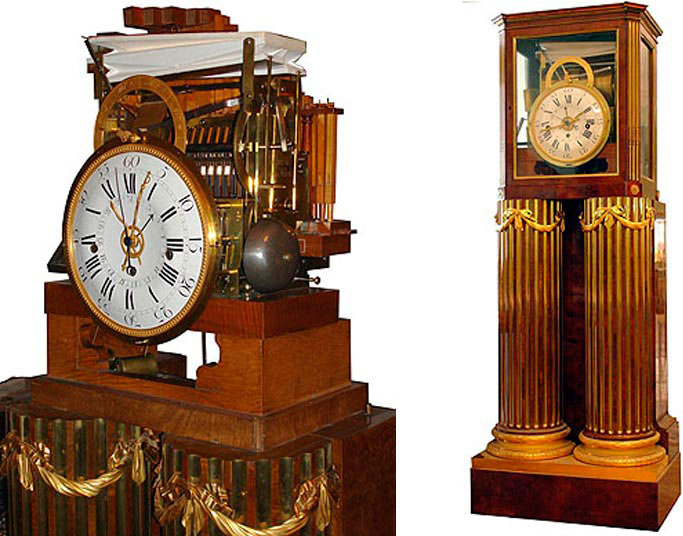
Musical clock of XVIII century
Day and night watchmakers, fans of the business, were looking for a convenient means of determining the time. A little later, but it was in the 17th century, there appeared watch glasses to protect the dial. Naturally, the watch with the so-called tubercles became secondary, and was even on the third plan, because then it became inconvenient to determine. The times were not quiet, science does not stand still, people always wanted to something, and sometimes these aspirations lead to something constructive ... Modest inventions took place. Almost simultaneously with the appearance of a pocket watch there appeared pockets on clothes (it would seem that it may be easier ... and older. But no!). So with the appearance of such an important attribute in the clothes (well call it so ...) as pockets, there was a need to protect the watch from additional moisture, dirt and dust. That’s why the watch mechanism was concealed in two and sometimes even three cases, a kind of "Matryoshka". This situation required a different approach to the definition of time in the dark. One of the most interesting and unusual discoveries at the time were striking clock on demand. Their huge plus was that they did not stray from the mechanism stops. The mechanism of the stroke as if repeating the readings of time on the dial.
|

Striking clock of 1600-1610s. Master Michael Nouen (London)
|
.jpg)
Striking clock, 1680
|
The earliest mention of the watch-repeater dates back to 1676. We have in mind a watch that is allowed to beat the current time on demand. That is a hint of independence has already been. The first mechanism was invented by Edward Booth, also known as Edward Barlow. At that time it was the deskclock. Ten years later, in 1686, the English master Daniel Kuea invented the first miniature clock repeater. March 2, 1687 he got a patent for the invention repeater of quarters (what it is, we will discuss later). At the same time, Edward Booth presented to humanity a quarter portable repeater. But it was also not without backroom "wars", and all the glory went to Daniel Kuea (king of England, James II contributed to this). Repeaters of Booth or Barlow were built on two combs, separately for minutes and hours. Today it is the most common pattern. It should be noted that the repeater of Kuea was created on the same comb, but in an alarm clocks, repeaters and watches with stroke was used a system "hammer-bell." Hammer was mounted in the recess on the case back and the size was the same with it. Watch with such a case of course, was a quite thick. In 1695, the masters presented half-quarter repeater, in it a quarter snail spoke had 8 steps instead of 4.
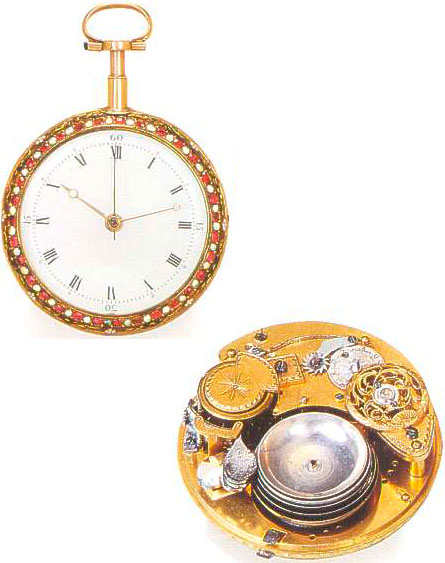
Pocket watch by a wizard Jacquet-Droz with a 5-bell carillon, 1785
There is no limit to perfection. In 1740, a master Blian Leroy invented a thinner repeater. He simply refused to bell, replaced it with a metal bar. The resulting sound of repeater was muffled. It became possible to determine the time, without disturbing others. Such watches are popularly called nocturnal or deaf repeater. In 1750, another famous master Thomas Mudge has created one of the first option of common today anchor course - the first minute-repeater watch, beats a minute and a quarter hours. And well-known Abraham Louis Breguet made a breakthrough in the history of watchmaking - he reduced the size of the "speaking clock". The maestro refused bell and replaced it with gongs. Gongs are metal pins rather complex form, attached on one side. And to sound watch music better in fixing, the size of the bell is slightly smaller in a diameter. Originally gongs were located along bridges on the board. But this design was quite limited by the length of the bell, and with it the tone of the sound. That is why further gongs started to place a circle, around the mechanism. Therefore it is no wonder that the length of gongs increased about three times, in addition, it is possible to use different tones and sounds of different pitch.
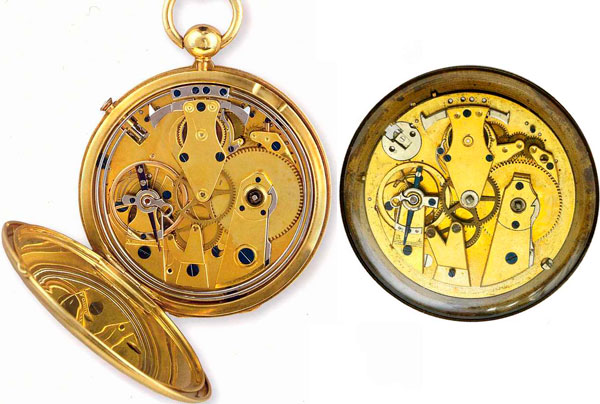
Classic quarter repeater of caliber Breguet
Soon, there appeared one invention that would get rid of quite a large bell, it is a watch with mechanical music. In it was used a steel comb, but not simple, but with teeth of varying length, and thus the tone was different from them. The music played thanks to a special wheel which clung to the comb. The appearance of miniature watch with music owed Antoine Favre, who first introduced this unusual mechanism already in 1796. And by 1800 the "speaking watch" became available to ordinary citizens. Further the process of improvements repeaters was purely technical.
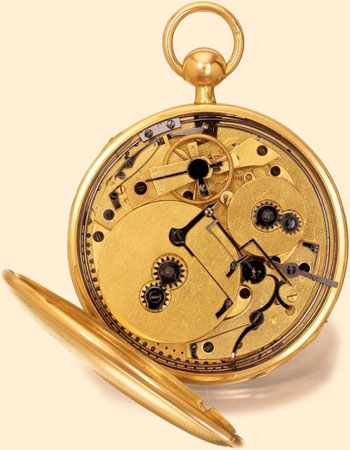
Typical French musical repeater of 1820s
Before 1845, when von Shrotter invented matches, fire extracted by striking flint against a piece of steel. Sparks were sent to the tinder or canvas, they began to smolder. After that, you can light a candle and watch the time. And if the watch movements had a function of the current time beating or repeater, the lack of lighting at night was compensated. Quite often in desktop or wall clock was a cord that hangs from the case. If pull it, the stroke of last hour repeated. There was even a model where the stroke of quarters repeated too. Pocket watches in their turn supplied with pushbutton device by clicking on which you can make gear to beat a minute, full hour and fifteen minutes. Sometimes pocket watches were equipped with more sophisticated devices - jacks (more on them below) - automatically moving figures. There were surprises also for music lovers - watches playing tunes popular at that time.
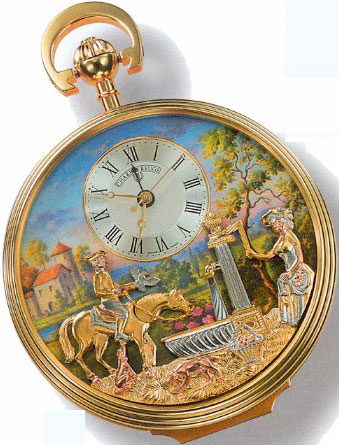
Reuge musical pocket watch with automatons
Repeaters and striking watch, depending on their ability are divided into several types:
•Quarter-repeater, or repeater, beats quarter. Mechanism sounds every hour and every quarter of an hour with 2 sounds of varying heights.
•Half-quarter-repeater, or repeater, beats half of the fourth, sounds of a quarter and every hour on two different pitch, and half a quarter - a short sound.
•Five-minute-repeater, which sounds every five minutes and every hour with two different sounds.
•Minute-repeater, a mechanism beats minute and a quarter by two different sounds.
•Grande Sonnerie – it is a repeater, which automatically beats a quarter and hour. Repeats the hours and number of hours of each quarter, as well as a minute and a quarter on demand.
•Petite Sonnerie – is a repeater, which beats quarters and hours, but does not repeat the number of hours each quarter.
Repeaters Grande Sonnerie and Petite Sonnerie are equipped with a special locking mechanism, which by the owner desire stops the sound mechanism.
Unrivaled masters in production of watches with repeater are considered such companies as Patek Philippe, Breguet, Audemars Piguet, Vacheron Constantin, Blancpain, Ulysse Nardin, Kelek. Patek Philippe has created a real masterpiece of musical art of watchmaking – a pocket model Star Caliber 2000 with mechanics like Grande Sonnerie, which accurately replicated the 16-note melody of Westminster chimes (London Big Ben), in the case were placed five gongs of different heights.
Dear reader, repeaters by Breguet are known still at school. Do not be surprised. This is so. Or have you not read "Eugene Onegin"? Everything is simple - a prototype of such a watch father of Pushkin got from Paris in 1804. This mechanism was much loved for its wonderful stroke not only by the family of Alexander, but also by Richard Wagner, Peter Ilyich Tchaikovsky. Sir Winston Churchill never parted with his repeater, which he got from his grandfather's inheritance.
.jpg)
Eugene Onegin
The very first wristwatch with minute repeater was created by masters of the company Audemars Piguet in 1892. The other brands did not lag behind and produced exceptional musical watch mechanisms. So initially such watches were not for sale in the broadest sense of the word, but only to maintain the brand and prestige. It was only after some time - in the 1980s of the 20th century - a watch with music became an irreplaceable part of famous wrist models, while continuing to remain unique and rare commodity.
It should be noted (imagine a skeptical expression on the faces of fans of musical watch exclusively handmade ... Kindly be tolerate...), that in addition to the mechanical watch with repeater appeared its electronic version. The company Citizen was one of the first providers of those watches to the public. When you press the button, the chronograph emulates work of minute repeater. The company ETA went on - it has released a version of quartz movement with minute repeater. Watch is equipped with an alarm clock, stopwatch, second time, timer, analog hands and two displays. Even if the judges of "antiquity" will continue to indulge in snobbery, deep down they recognize that it is also unique watch, unique in electronic niche.
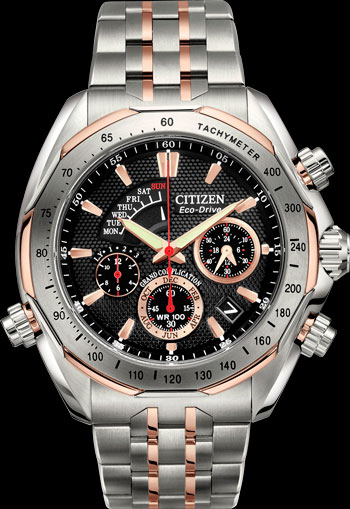
Electronic watch with repeater Citizen Signature Collection Grand Complication (Ref. BZ0016-50E)
1986 year can rightly be called "the year of the second coming" of repeaters. Frederic Piguet and Blancpain, who developed the ultra-thin mechanism with repeater. Later their example were followed by Franck Muller, IWC, Jaeger-LeCoultre, Piaget, and many other leading figures of watchmaking. However, not every brand would dare to issue such unique "devices", as assemble them incredibly difficult - the mechanism consists of at least 300 components, and not everyone can afford to buy such a watch because of their high cost. Although in the form of collection exceptions any company sometimes release a repeater to show off at the Basel exhibition.
Dancing Men or Jacks ...
In fact, this is not the Dancing Men but kind of repeaters. On the dial are small figures that move in time with the gong. "And in the process of imagination it is created the impression that the dolls dance by themselves ...". Today the company Ulysse Nardin is the most advanced in this area. We can say this is its speciality, despite the fact that Ulysses Nardan thunders also as a producer of unique "marine watches."
Historically, the Ulysse Nardin –a watch manufacture of the town Le Locle – is famous for its unusual marine chronometers. That is why the pavilion of the brand at jewelry and watch fair in Basel has porthole windows and painted on the wooden walls of the stand sails. However, their second birth jacks (tiny, but quite extensive figures, which are located on the dial) must Rolf Schnyder, a businessman from Zurich, who once literally saved from death watch factory.
|
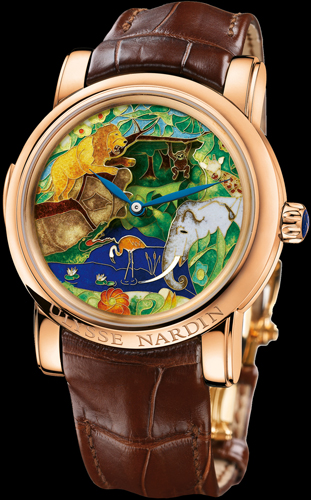
Safari Jaquemarts Minute Repeater (Ref. 726-61)
|
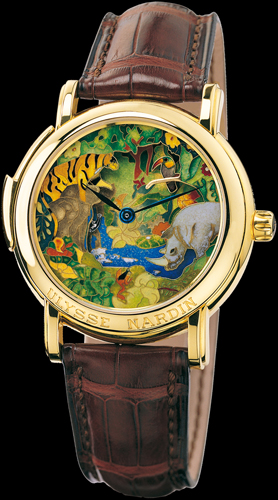
Jungle Minute Repeater (Ref. 721-22)
|
Almost every year in famous certain artistic line of Ulysse Nardin appears a new model with legendary jacks, or something adds to the old line. It would seem antediluvian but watches- jacks have become the main part of the brand Ulysse Nardin. But not only the brand, but also the whole world. Thousands of fans of this rarity are in almost every country, ready, if not to buy such an expensive piece, at least just to enjoy it at the show.
Jacks’ homeland is the town Le Locle. This place is booming all over the world, because there is one of the most famous watch museums. Ulysse Nardin watches are designed to suit every taste - all colors, seen or unseen, - amusing, even funny, old, beautiful, unusual, a little silly, but catchy, takes us back to a time when a musical clock was still not able to measure the second, but surprise with sophisticated (in terms of technology) design.
But jacks is a watch with a complicated, serious mechanism, called a minute repeater. This complicated, collection, difficult, rare, museum level mechanism with minute repeater was patented in Switzerland, as one might think, and in the United Kingdom was patented by a watchmaker Daniel Kwara in the late 18th century. The very first watch repeater appeared only in the 1880's.
What is the minute repeater? This is a wonderful watch that can not only tell time, but also sounds it, as one of the main tasks of the repeater is to play battle, issued in the position of the segments gongs. This is mainly music-hour invention "represents" sounds of Westminster stroke. This means that it plays a total of four tunes - E, C, D, and G. These four gongs beat different sequences for different quarters of an hour. Gongs, in fact, are very important part in the mechanism. Without work of gongs of Westminster stroke no one figure on the dial is not in motion, it is still an animal or human. Jacks partly include toys, but they are made with a certain amount of didactics. What is it? We can say that to some degree picture of the dial - is preachy stuff. Plots for these multi-figured compositions bit like parables.
For example, a watch "Genghis Khan", which exists in two versions – with diamond set Haute Joaillerie and without diamonds. Royal rider at the sound of a gong starts to swing the sword. When re-tune, two soldiers began battle. Historical line, the model of "Genghis Khan", in particular, continues another masterpiece - "Alexander the Great". The course is the same - as soon as bell is heard, gold figures immediately take hawkish. Prerequisite: jacks’ movements need to be synchronized with the sounds that puts hour, quarter hours and minutes.
|
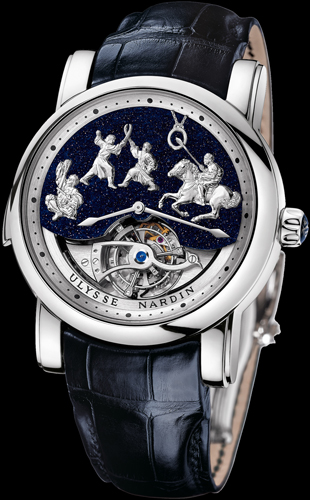
Genghis Khan (Ref. 789-80)
|

Alexander the Great Westminster Carillon Tourbillon (Ref. 780-90)
|
It should be noted that not only the most famous historical characters and scenes become members of a small musical drama theater on the dial - "scene." No less popular secular themes, which send us to the medieval miracle plays. For example, a model Jaquemarts Minute Repeater Circus Aventurine. In this watch a dial is set with an unusual multi-figure compositions, which shows the circus arena. All six figures are carved from gold by hand (this is required in the manufacture of jacks). Once the mechanism of jacks is triggered, a clown begins juggling balls, and a circus monkey should to catch them. At this time a trainer is waving a whip in front of a tiger. Simultaneously there is a stroke of a quarter of an hour. In time of minutes’ stroke, gold tiger moves its paw. During all that time as the striking mechanism is working, amiable bear bow ballerina.
|
.jpg)
Circus Minute Repeater (Ref. 740-88)
|
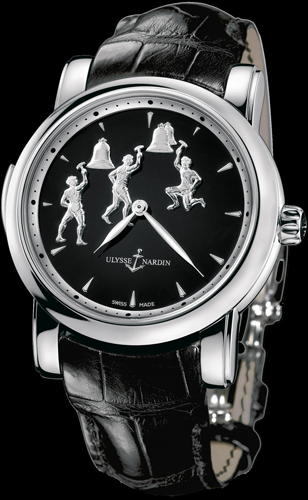
Triple Jack Minute Repeater (Ref. 739-61/E2)
|
In the manufactory Ulysse Nardin in the creation of a watch with jacks is always engaged the same master. Time for creation, depending on the complexity of the composition can have between one and four months. Sometimes, as in the case of "Genghis Khan", to the base mechanism of the minute repeater is added node of tourbillon. As mentioned above, from a technical point of view jacks - is precious watch. Very often, the wizards add real precious items, such as Aventurine, from which is usually made dial, or diamonds - they often decorate bezel.
Automaton – the first "computer"
Yes, automatons is popularly called such. This is no accident. Moving figures - automatons - are able to move on their own. Wherever they are shown, they are bound to bring joy, so skillfully masters created them. Today, this work of art can be seen in the Museum of History and Art in Neuchatel (Switzerland). However, Moscow has also something to brag about - on the facade of the Moscow Puppet Theatre is a such "theater", where every hour automatons-scenes artists plays scenes and thus attract the audience.

The facade of the Moscow Puppet Theatre
As the clocks began to be placed in the room and even on the table (and not somewhere on the tower in the center of the medieval city), the mechanisms are provided with moving figures. After a while there were a pocket watch-carillon, which "nest" of bells is mounted on a common axis, thus creating the music in the allotted time. The most famous brand producing watches-automatons and automatons–“toys”, is Jaquet Droz, named after the "founding father" Jaquet Droz. It was he, who first started making animated musical clock with singing birds and fountains, as well as automatons or androids - humanlike mechanical dolls.
In Neuchâtel, in the art - historical Museum, are exhibited three automatons, which are workable - Musician, Clerk, or Calligraphers and Artists. The exhibition had and today also has a huge success. People came from distant cities and countries to see the eighth wonder of the world. Wishing to see the dolls is very much even now. On Sundays, once a month, in the museum is organized demonstrations of automatons. The Clerk is a doll about 70 cm in height - it is a young man sitting on a stool at a table made of mahogany. The doll has an inkwell, a quill pen, and even a dozen European languages. The automaton displays with calligraphic handwriting in Spanish, English and French inscription «Les automates Jaquet Droz a Neuchatel». The Artist – is a young man - automaton, painting miniatures on the "request" of customers, mostly asking to depict profiles of French monarchs or a dog, because it is a favorite animal of King Louis XVI. The Musician – is a large lady, more than Clerk and Artist in twice. She sits in a chair for the piano, singing "to order" a beautiful melody.

Automatons: Artist, Musician and Scribe
For 2013 and 2014 the watch house Jaquet Droz has grandiose plans - the release of the unusual watches, close to the concept of a mechanical doll Pierre Jaquet Droz. We can already say that the new mechanism will be very interesting to collectors. Well, wait and see!
In conclusion, I would say that there is no limit to perfection, so the musical clocks and watches now continue to delight us with their "Evening Bells." Although the cost of these works of art is very high, clock-repeater and watch-repeater with jacks, and even more automatons – are not cheap, but they are worth it ... In any case, if you have the opportunity to touch history, do it, feel on your hand "live", beating, breathing mechanism of musical watch!
Written by Valya
|


